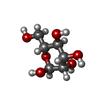[English] 日本語
 Yorodumi
Yorodumi- PDB-1kj1: MANNOSE-SPECIFIC AGGLUTININ (LECTIN) FROM GARLIC (ALLIUM SATIVUM)... -
+ Open data
Open data
- Basic information
Basic information
| Entry | Database: PDB / ID: 1kj1 | ||||||
|---|---|---|---|---|---|---|---|
| Title | MANNOSE-SPECIFIC AGGLUTININ (LECTIN) FROM GARLIC (ALLIUM SATIVUM) BULBS COMPLEXED WITH ALPHA-D-MANNOSE | ||||||
 Components Components |
| ||||||
 Keywords Keywords | PLANT PROTEIN / BULB LECTIN / MANNOSE | ||||||
| Function / homology |  Function and homology information Function and homology information | ||||||
| Biological species |  | ||||||
| Method |  X-RAY DIFFRACTION / X-RAY DIFFRACTION /  MOLECULAR REPLACEMENT / Resolution: 2.2 Å MOLECULAR REPLACEMENT / Resolution: 2.2 Å | ||||||
 Authors Authors | Ramachandraiah, G. / Chandra, N.R. / Surolia, A. / Vijayan, M. | ||||||
 Citation Citation |  Journal: Acta Crystallogr.,Sect.D / Year: 2002 Journal: Acta Crystallogr.,Sect.D / Year: 2002Title: Re-refinement using reprocessed data to improve the quality of the structure: a case study involving garlic lectin. Authors: Ramachandraiah, G. / Chandra, N.R. / Surolia, A. / Vijayan, M. #1:  Journal: J.Mol.Biol. / Year: 1999 Journal: J.Mol.Biol. / Year: 1999Title: Crystal Structure of a Dimeric Mannose-Specific Agglutinin from Garlic: Quaternary Association and Carbohydrate Specificity Authors: Chandra, N.R. / Ramachandraiah, G. / Bachhawat, K. / Dam, T.K. / Surolia, A. / Vijayan, M. #2:  Journal: Acta Crystallogr.,Sect.D / Year: 1997 Journal: Acta Crystallogr.,Sect.D / Year: 1997Title: Crystallization and Preliminary Crystallographic Studies on the Mannose-Specific Lectin from Garlic Authors: Chandra, N.R. / Dam, T.K. / Surolia, A. / Vijayan, M. | ||||||
| History |
|
- Structure visualization
Structure visualization
| Structure viewer | Molecule:  Molmil Molmil Jmol/JSmol Jmol/JSmol |
|---|
- Downloads & links
Downloads & links
- Download
Download
| PDBx/mmCIF format |  1kj1.cif.gz 1kj1.cif.gz | 102.7 KB | Display |  PDBx/mmCIF format PDBx/mmCIF format |
|---|---|---|---|---|
| PDB format |  pdb1kj1.ent.gz pdb1kj1.ent.gz | 80.8 KB | Display |  PDB format PDB format |
| PDBx/mmJSON format |  1kj1.json.gz 1kj1.json.gz | Tree view |  PDBx/mmJSON format PDBx/mmJSON format | |
| Others |  Other downloads Other downloads |
-Validation report
| Arichive directory |  https://data.pdbj.org/pub/pdb/validation_reports/kj/1kj1 https://data.pdbj.org/pub/pdb/validation_reports/kj/1kj1 ftp://data.pdbj.org/pub/pdb/validation_reports/kj/1kj1 ftp://data.pdbj.org/pub/pdb/validation_reports/kj/1kj1 | HTTPS FTP |
|---|
-Related structure data
| Related structure data | 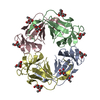 1msaS S: Starting model for refinement |
|---|---|
| Similar structure data |
- Links
Links
- Assembly
Assembly
| Deposited unit | 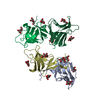
| ||||||||||
|---|---|---|---|---|---|---|---|---|---|---|---|
| 1 | 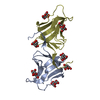
| ||||||||||
| 2 | 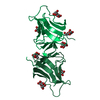
| ||||||||||
| Unit cell |
|
- Components
Components
| #1: Protein | Mass: 11988.233 Da / Num. of mol.: 2 / Source method: isolated from a natural source / Source: (natural)  #2: Protein | Mass: 12169.442 Da / Num. of mol.: 2 / Source method: isolated from a natural source / Source: (natural)  #3: Sugar | ChemComp-MAN / #4: Water | ChemComp-HOH / | Has protein modification | Y | |
|---|
-Experimental details
-Experiment
| Experiment | Method:  X-RAY DIFFRACTION / Number of used crystals: 1 X-RAY DIFFRACTION / Number of used crystals: 1 |
|---|
- Sample preparation
Sample preparation
| Crystal | Density Matthews: 3.2 Å3/Da / Density % sol: 59.6 % | |||||||||||||||||||||||||
|---|---|---|---|---|---|---|---|---|---|---|---|---|---|---|---|---|---|---|---|---|---|---|---|---|---|---|
| Crystal grow | Temperature: 293 K / Method: vapor diffusion, hanging drop / pH: 7 Details: 20% PEG 8000, 5.5 MG/ML PROTEIN, 10MM MANNOSE, 20MM PBS, 1WEEK, pH 7.00, VAPOR DIFFUSION, HANGING DROP at 293K | |||||||||||||||||||||||||
| Crystal grow | *PLUS Temperature: 294 K / pH: 7 Details: Chandra, N.R., (1997) Acta Crystallogr., Sect.D, 53, 787. | |||||||||||||||||||||||||
| Components of the solutions | *PLUS
|
-Data collection
| Diffraction | Mean temperature: 298 K |
|---|---|
| Diffraction source | Source:  ROTATING ANODE / Type: RIGAKU RU200 / Wavelength: 1.5418 / Wavelength: 1.5418 Å ROTATING ANODE / Type: RIGAKU RU200 / Wavelength: 1.5418 / Wavelength: 1.5418 Å |
| Detector | Type: MARRESEARCH / Detector: IMAGE PLATE / Date: Jun 15, 1997 / Details: MIRRORS |
| Radiation | Protocol: SINGLE WAVELENGTH / Monochromatic (M) / Laue (L): M / Scattering type: x-ray |
| Radiation wavelength | Wavelength: 1.5418 Å / Relative weight: 1 |
| Reflection | Resolution: 2.2→20 Å / Num. obs: 29430 / % possible obs: 90.3 % / Redundancy: 3.5 % / Biso Wilson estimate: 14.9 Å2 / Rmerge(I) obs: 0.104 / Net I/σ(I): 14.4 |
| Reflection shell | Resolution: 2.2→2.28 Å / Redundancy: 2 % / Rmerge(I) obs: 0.436 / Mean I/σ(I) obs: 2.3 / Num. unique all: 1791 / % possible all: 55.8 |
| Reflection | *PLUS Highest resolution: 2.2 Å / Lowest resolution: 20 Å / Num. measured all: 102203 |
| Reflection shell | *PLUS % possible obs: 55.8 % / Num. unique obs: 1791 |
- Processing
Processing
| Software |
| ||||||||||||||||||||||||||||||||||||||||||||||||||||||||||||||||||||||||||||||||
|---|---|---|---|---|---|---|---|---|---|---|---|---|---|---|---|---|---|---|---|---|---|---|---|---|---|---|---|---|---|---|---|---|---|---|---|---|---|---|---|---|---|---|---|---|---|---|---|---|---|---|---|---|---|---|---|---|---|---|---|---|---|---|---|---|---|---|---|---|---|---|---|---|---|---|---|---|---|---|---|---|---|
| Refinement | Method to determine structure:  MOLECULAR REPLACEMENT MOLECULAR REPLACEMENTStarting model: SNOWDROP LECTIN (PDB ENTRY 1MSA) Resolution: 2.2→20 Å / Rfactor Rfree error: 0.005 / Data cutoff high absF: 245621.09 / Data cutoff low absF: 0 / Isotropic thermal model: RESTRAINED / Cross valid method: THROUGHOUT / σ(F): 0
| ||||||||||||||||||||||||||||||||||||||||||||||||||||||||||||||||||||||||||||||||
| Solvent computation | Solvent model: FLAT MODEL / Bsol: 51.3531 Å2 / ksol: 0.330189 e/Å3 | ||||||||||||||||||||||||||||||||||||||||||||||||||||||||||||||||||||||||||||||||
| Displacement parameters | Biso mean: 40 Å2
| ||||||||||||||||||||||||||||||||||||||||||||||||||||||||||||||||||||||||||||||||
| Refine analyze |
| ||||||||||||||||||||||||||||||||||||||||||||||||||||||||||||||||||||||||||||||||
| Refinement step | Cycle: LAST / Resolution: 2.2→20 Å
| ||||||||||||||||||||||||||||||||||||||||||||||||||||||||||||||||||||||||||||||||
| Refine LS restraints |
| ||||||||||||||||||||||||||||||||||||||||||||||||||||||||||||||||||||||||||||||||
| LS refinement shell | Resolution: 2.2→2.34 Å / Rfactor Rfree error: 0.023 / Total num. of bins used: 6
| ||||||||||||||||||||||||||||||||||||||||||||||||||||||||||||||||||||||||||||||||
| Xplor file |
| ||||||||||||||||||||||||||||||||||||||||||||||||||||||||||||||||||||||||||||||||
| Software | *PLUS Name: CNS / Version: 0.4 / Classification: refinement | ||||||||||||||||||||||||||||||||||||||||||||||||||||||||||||||||||||||||||||||||
| Refinement | *PLUS σ(F): 0 / % reflection Rfree: 9.7 % | ||||||||||||||||||||||||||||||||||||||||||||||||||||||||||||||||||||||||||||||||
| Solvent computation | *PLUS | ||||||||||||||||||||||||||||||||||||||||||||||||||||||||||||||||||||||||||||||||
| Displacement parameters | *PLUS Biso mean: 40 Å2 | ||||||||||||||||||||||||||||||||||||||||||||||||||||||||||||||||||||||||||||||||
| Refine LS restraints | *PLUS
| ||||||||||||||||||||||||||||||||||||||||||||||||||||||||||||||||||||||||||||||||
| LS refinement shell | *PLUS Rfactor Rfree: 0.37 / % reflection Rfree: 9.2 % / Rfactor Rwork: 0.334 |
 Movie
Movie Controller
Controller


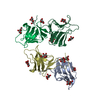

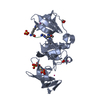
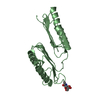
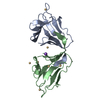
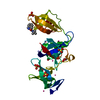
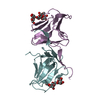


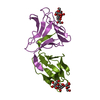

 PDBj
PDBj



